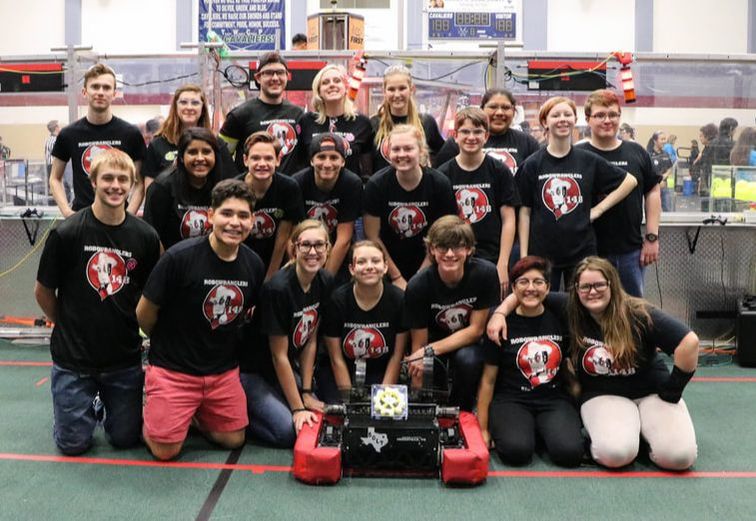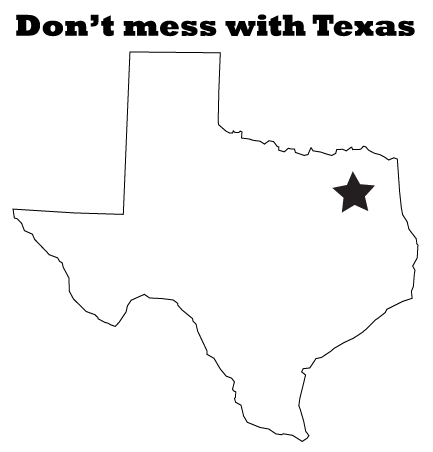About the Robowranglers
The Robowranglers are a team of students and mentors from Greenville, TX who compete in the FIRST Robotics Competition. Students design and build 150 lb robots to battle head-to-head in a sports-like game against over 4,000 schools from around the world.
Robowrangler Pride
The Robowranglers have been going strong since 1992 and are the oldest robotics team in Texas. In the team’s 27 year history the Robowranglers have made multiple appearances in the Final Four winning three World Championships and earning over 30 awards for technical excellence.
The Robowranglers are regarded as one of the best robotics programs in the world, even being invited by the Chinese government to visit their country and expand its robotics community.
The Robowranglers are regarded as one of the best robotics programs in the world, even being invited by the Chinese government to visit their country and expand its robotics community.
What Our Students Learn
The Robowranglers equip the STEM leaders of tomorrow with the tools they need today. Through their involvement on the team, the students of Greenville, TX are getting lessons for wherever life leads.
The competition is structured to mirror a real-world design challenge, as such students get a unique opportunity for hands-on learning while partnering directly with industry professionals.
The competition is structured to mirror a real-world design challenge, as such students get a unique opportunity for hands-on learning while partnering directly with industry professionals.
Technical SkillsUsing the technical skills they develop on the team, Robowrangler students intern with local tech companies while still in high school; they do product development and design work before ever attending college.
|
21st Century Soft SkillsRobowrangler students get the chance to practice the “soft skills” they need to be successful in the modern workplace. While many companies are struggling to find employees with these skills, our students are crafted into workforce-ready leaders who have mastered the concepts of problem solving, critical thinking, and teamwork.
|
Life Lessons
|
Perhaps most importantly, Robowrangler students are given the chance to solve very difficult problems. This competition is sometimes described as “the hardest fun you’ll ever have.”
Robowranglers Learn:
When you spend your time solving problems, you spend a lot of time with failure. This is where Robowranglers receive the hardest lessons, and the team can provide its biggest impact. Robowranglers Learn:
|
|
Greenville, TX Unites to Compete on the World Stage
The impact of the Robowranglers would not be possible without the support of our entire community. We’re proud to be representing Greenville, TX on the world stage!
|
When they started the Robowrangler robotics program, Greenville ISD cemented their position as pioneers of the hands-on, project based learning so common today. Now the district has groundbreaking STEM programs available for students of all age levels, and has over 500 students involved in robotics feeding the Robowrangler High School team.
In the Fall of 2016 GISD opened their new Career and Technical Education Center and at its heart: the new home of the Robowranglers. Including a full-size robot arena with spectator stands, this state-of-the-art Robowrangler lab and practice facility shows the dedication of the Greenville community to the team’s ongoing success and impact. The FIRST Robotics Competition is unique in that it asks industry professionals to work hand-in-hand with high school students on an engineering challenge. The powerful lessons our team provides would not be possible without a group of dedicated volunteers from the community mentoring the Robowrangler students. Many are alumni themselves of the Robowranglers and most of these individuals come from one of two local companies: |
|
Some companies start robotics teams, the Robowranglers started a company. Innovation First International (IFI) was founded by two young engineers Tony Norman and Bob Mimlitch who met while mentoring the Robowranglers. They took the values & principles which brought them success in the fast-paced competition robotics sport and built a company around them.
Tony and Bob have always been forces of positive change within Greenville community and school district. From the company’s beginning in 1999, they made sure IFI would always support the team, and since 2007 IFI has been the title sponsor of the Robowranglers. Their industrial CNC and sheet metal manufacturing capabilities help our robots maintain the iconic look for which we’re known. In addition they employ many of the professionals that serve as team engineers & mentors. Many of these IFI employees are former Robowranglers themselves! |
L-3 has supported the team since its inception. As the founding sponsor of the Robowranglers, their continuing, long-term support of the team is a testament to their commitment to STEM and the students of Greenville. The mentors from L-3, some of whom have been mentoring this program for almost three decades, remain the cornerstone on which the Robowranglers are built!
|





